TVU RPS One Hardware User Guide
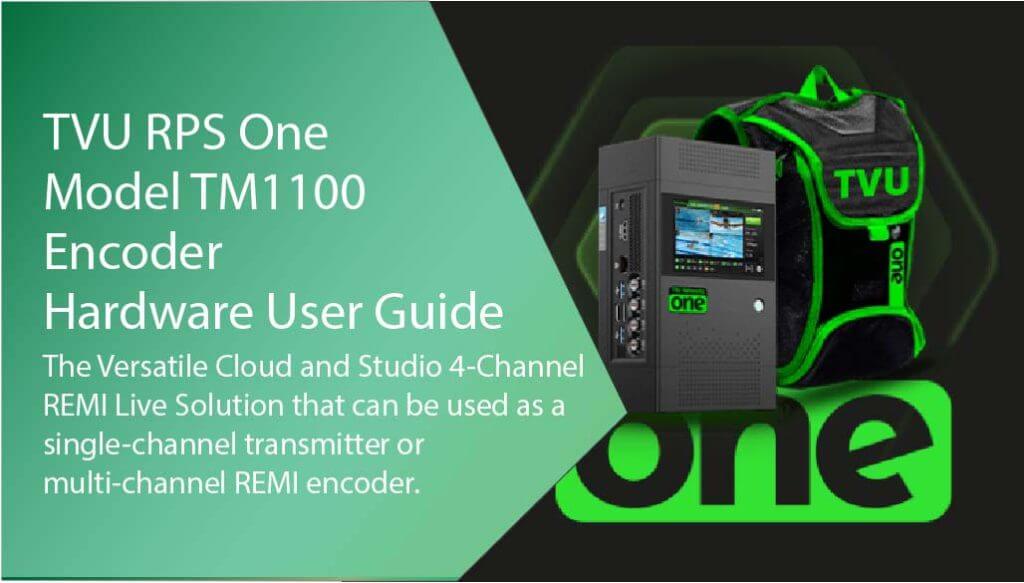
Chapter 1 – Introduction, setup, and base operation
TVU Networks “One” is the latest generation portable TVU transmission device. The TVU Networks RPS One is based on the latest TM1100 hardware, the smallest and lightest encoder in its class.
Product overview
The One features up to 12 connections and an enhanced Inverse Statmux Plus, TVU’s next-generation transmission protocol. It also features six next-generation, sub-6GHz 3GPP Release 16 5G modems with an advanced antenna array that supports multiple antennas for each modem, making the One compatible with the most advanced 5G networks, including future network slicing.
The TVU Networks One hardware can be used with two different software variations. The One (single-channel transmitter) or RPS One (multi-channel REMI encoder).
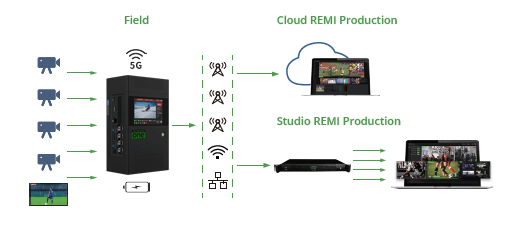
With wireless connectivity, unparalleled transmission speeds, and superb multi-camera production performance, the TVU RPS One is the perfect addition to the already most powerful REMI and cloud-based production platform in the industry. This wireless encoder supports up to 4 synchronized SDI inputs for 1080p HDR remote production and up to 4 hours of autonomy when paired with TVU POWERPAC for uninterrupted live production.
This solution supports six embedded worldwide 5G modems with LTE/3G fallback and aggregates up to 12 connections, including Starlink, WiFi, Ethernet, BGAN, and more. TVU RPS One supports up to 125 Mbps for unmatched Connectivity.
TVU RPS One boasts an innovative 5G MIMO antenna array that guarantees the seamless operation of all built-in 5G modems simultaneously at peak performance. This remarkable feature is complemented by six next-generation 3GPP Release 16 modems, which provide comprehensive support for 5G SA and NSA modes and compatibility with the most widely used 5G.
Additionally, the RPS One’s dual WiFi modules, equipped with MIMO antennas, ensure top-notch connectivity with local devices and multiple available networks concurrently, delivering unmatched performance and versatility in wireless communication. LTE and 3G bands across the globe.
Current RPS One 4-channel receiver options:
- Transceiver (Quad, dual, and single) 2x DualR, 1x QuadR
- Cloud (TVU Producer, TVU Channel, MediaMind, and CloudR
TVU RPS One features
- 5G ready – 5G x6 cellular aggregation encoder for remote production
- Versatile hardware design and operation – The RPS One 4-Ch REMI Live encoder and The “One” single-channel live transmitter share the same Model TM1100 hardware. Single-channel transmitters ship with BNC silicon caps for unused SDI ports.
- The One 1-Channel (V4) transmitter can be upgraded – To an RPS One 4-Channel REMI Live encoder if needed (temporarily or permanently). The RPS One functionality is controlled via feature control and the software version is user upgradable on the LCD touchscreen.
- Rugged chassis – CNCed from high-density aluminum.
- Onboard removable battery – For up to two hours runtime with all four channels encoding and six 5G modems. Utilize the standard TVU One POWERPAC or any V-Mount/Gold Mount battery to extend runtime with hot-swap capability.
- Redesigned breathable backpack – With improved quality and durability.
- Reliable, low-latency, high-quality transmission – True 60 frame per second (full motion) 4K is available for Ch-1 as a standalone.
- All four SSDI inputs are active and available for REMI transmission – It can operate as a single, 2-channel, 3-channel, or 4-channel encoder if needed.
- SDI source switch mode – Allows seamless switching between the user’s SDI inputs from the touchscreen and Web UI. Supports 4 SDI source switching using a USB keyboard or Stream Deck controller.
- Simultaneously aggregates up to 12 data connections – including internal/external cellular, WiFi, Ethernet, IP Microwave, and Satellite (Ka/Ku/BGAN/Starlink).
- The RPS One includes – Up to 6 embedded 4G/LTE/5G modems that support LTE and 3G fallback, 2.4/5 GHz WiFi, Ethernet, and 4 USB connections for external modem connections.
- Supports LTE Category 12 global modems.
- Voice over IP remote production bidirectional communication.
- Onboard WiFi and external 2.4/5 GHz with MIMO antennas.
- Type 10 Micro SD support for up to 18 hours of high-quality video storage. The RPS One ships with a 128 GB SD card.
- Onboard SDI and HDMI input.
- HEVC/H.265 or H.264 video compression.
- Battery run times – Internal – 2 hours; External (POWERPAC) – up to 4 hours.
- Portable with one-button operation.
- Auto Sync support via USB drive.
- Audio-only transmission mode support. Lock the audio channel to a specific input when using the SDI Switch function.
- The RPS One supports RVF control via touch screen and includes an RVF option for viewing return video feed from an iPhone or iPad.
- RVF support – TVU Producer, TVU Partyline, or SDI input at Server Hotspot stream on the same server.
- VLAN mode support – Can connect to the receiver’s VLAN without having a router data plan.
- GPS and Partyline status display.
- Decoder options:
- Transceiver (quad, dual, single)
- Cloud (TVU Producer, TVU Channel, MediaMind, and CloudR
Contents and functions
TVU RPS One encoder model TM1100 has a robust hardware design and functions to fit the needs of any live broadcaster. The TVU RPS One runs on the TVU platform and includes the following functions:
- Simple Worry-Free Operation – One button power-on, onboard monitoring and management, remote monitoring and management using a mobile smart device or the TVU Command Center web service. RPS One requires no in-field configuration and boots up in less than 30 seconds.
- Small Form Factor, Big Features – RPS One is feature-rich with no compromises to performance or capabilities. To see a full list of hardware and software specifications for the TVU RPS One, refer to “Product Specifications.”
- Inverse StatMux Plus – RPS One features proprietary video transmission technology called Inverse StatMux Plus (IS+). With IS+, the unsurpassed HD picture quality is dependably delivered at sub-second latency over cellular 3G/4G/5G LTE modems, even when transmitting in a moving vehicle traveling at over 60 mph/100 kph.
- Powerful Real-Time Store and Forward – TVU RPS One can simultaneously live stream and record. TVU has HD file transfer functionality that ensures the delivery of an HD quality error-free video clip to the studio in real time without waiting until the clip is fully recorded on the encoder.
- Digital memory card slot and video storage – Supports a 128 GB SD card (providing 18 hours of high-quality video storage).
- Fully Compatible with TVU Grid – TVU’s IP-based video switching, routing, and distribution solution allows a broadcaster to share one live video transmission of an RPS with any other TVU Grid-enabled station, operations center, or physical location. TVU Grid features very low latency when switching, routing, or distributing live video.
- Support for TVU Partyline – Integrates with remote video conferencing as an RPS One source. The RPS One can also send RTIL streams to Partyline as a TVU device.
- TVU EcoSystem support – TVU is the only manufacturer with a complete Cloud platform for live production with Producer, Remote Commentator, Partyline, Channel, Grid, and Search/ MediaMind for time-stamped and synchronized transmissions.
- Support for return video feed HDMI adapter (onboard) – Use this device to receive a high-quality, low-latency SDI return feed in the field from a TVU receiver in the studio, where it can be monitored locally on an HDMI monitor.
- Improved audio quality – Optimized audio transmission quality and compatibility. Supports high bit-rate audio setting up to 320 Kbps.
- Support for external Bluetooth adapter (optional) – Communicate via VoIP wirelessly with an external Bluetooth adapter.
- 5G Ready – System includes up to 6 embedded 4G/LTE/5G modems.
- Support for external 5G devices – Connect to certain external 5G phones/MiFi devices to enable hotspot usage.
- Closed caption pass-through – Support for embedded pass-through of closed captions for 1080i and 720p.
- Speedtest feature – Supports speed testing of the transmission between the encoder and receiver.
- USB file upload – Supports USB file uploads from a flash drive.
- Stream control – Supports streaming output of a receiver remotely.
- Record function – View record list, preview, copy, and mark-in and mark-out functionality for segment uploads.
- Optional – 2160p 50/59.94 (4K) support with HDR support (HDR10 and HLG) on input 1.
- Encoding – Up to 20 Mbps encode bitrate for a single channel, up to 125 Mbps for 4K or RPS One use. Switchable HEVC or H264 encoding. Monitor the live-stream bitrate. If the selected transmission bitrate drops below the threshold, a visual notification is displayed on the home screen.
- 4.2.2 support – Up to 1080p on input 1.
- Easy operation – Improved touchscreen UI and Web Interface.
The TVU RPS One integrates with the TVU Command Center Web interface which provides a cloud-based centralized management and control solution of all TVU devices and services. For detailed information about TVU Command Center, refer to the TVU Command Center User Guide.
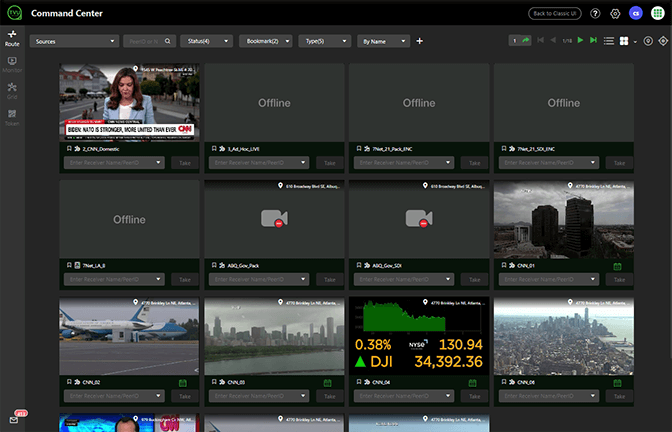
About this user guide
This user guide provides detailed information about the following topics:
- Important notices and guidelines
- RPS One encoder features and components
- Setting up the RPS One encoder
Notices and guidelines
NOTE: These notices provide important tips, guidance, or advice.
IMPORTANT: These notices provide information or advice that might help you avoid inconvenient or problem situations.
Before you begin
Before you begin setting up the RPS One encoder, it is recommended that you identify the devices you intend to use with the unit, including cameras, cables, power sources, modems, TVU services, and unit accessories.
The One/RPS One Software version 8.1 (Build 81349) or later uses the same hardware, which features two LCD console interfaces:
- The One single-channel transmitter
- TVU RPS One multi-channel encoder
Refer to the latest TVU RPS One software user guide for operational information.
RPS One encoder components
The RPS One encoder comprises the internal battery and embedded modems. Weighing just 2.2 lb./1 kg, the encoder fits easily in the average person’s hand.
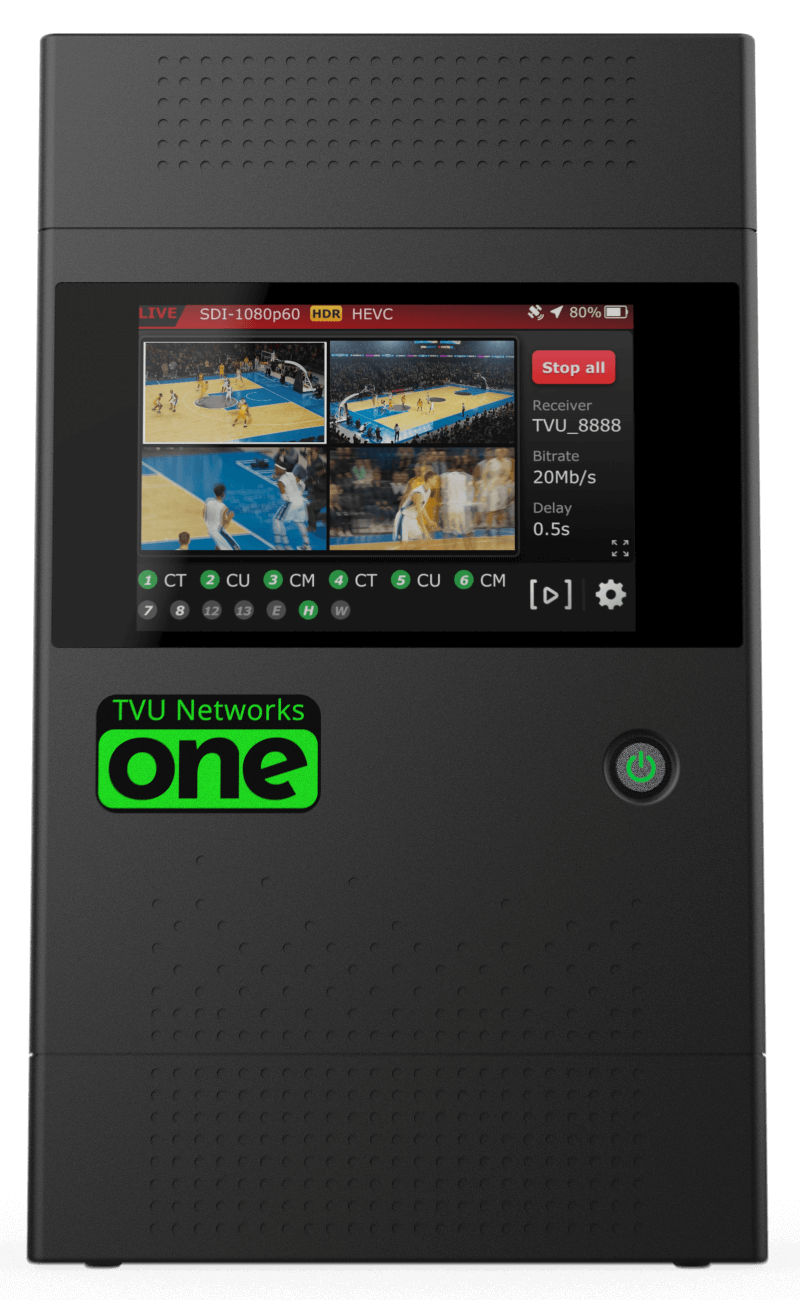
RPS One standard components
Standard components for the RPS One model TM1100 encoder include the following:
- TVU encoder with SDI/HDMI input
- 1x micro Internal SD slot
- 1x Micro SD card (128 GB) Type 10
- Internal USB connections (4x)
- 4x 1080p inputs with VBR
- Ethernet port
- IFB port
- Power supply (AC Adapter)
- TVU RPS One breathable backpack
RPS One optional components
Optional components for the RPS One include the following:
- SIM cards (nano)
- Micro SD card (256 GB) Type 10
- AC car adapter
- Universal adapter
- External modems
- MIMO antennas
RPS One controls and operations
The RPS One is the central component of the RPS One system. The RPS One handles video capturing, video encoding and transmission, modem management and dialing, and system status monitoring.
Front panel LCD and power indicator
Press the power button on the front panel to turn on the RPS One. The button turns green when the unit is powered on. The LCD screen displays configuration and status information for connected modems, including video input and transmission. When a video input is connected, an input preview is displayed on the LCD.
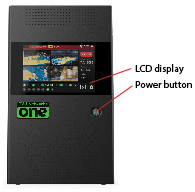
RPS One side panel overviews
The TVU RPS One encoder left-side and right-side panels feature the following input/output connections and controls.
Note: The One and RPS One share the same hardware. Changing a TVU one to the RPS One can be upgraded via Feature control.
TVU RPS One encoder left-side panel
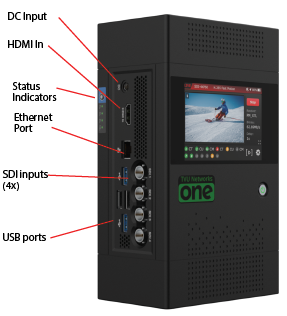
TVU RPS One right-side panel
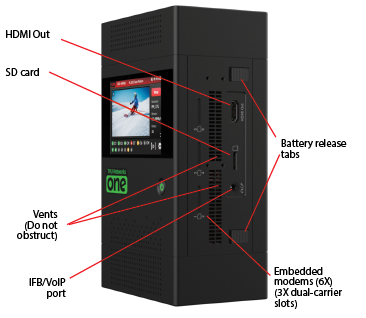
Chapter 2 – Setting up the RPS One
This section explains the encoder connections, detaching and charging the battery, how to remove and replace SIM cards, and backpack battery configurations.
Encoder connections
Complete the following steps to set up the RPS One encoder:
- Connect the HDMI cable to the HDMI In port.
- Connect the SDI cables to the SDI 1-4 ports.
- Connect the Ethernet input cable to the Ethernet port for a LAN connection.
- Connect your power to the DC Input port.
- Connect the audio component (3.5 mm mini audio output jack) to the IFB output port.
Detaching the internal battery from the encoder
The encoder’s internal battery is designed to fit within the unit and can be easily removed. Complete battery power management for the RPS One encoder is available on the LCD touchscreen and the receiver interface.
Complete the following steps to detach the internal battery from the encoder:
- Users will find two spring-loaded latches on the side of the encoder opposite the LCD touchscreen.
- Orient the encoder LCD panel down and push down on the latches to release the battery and slide it away from the encoder.
Battery release latches
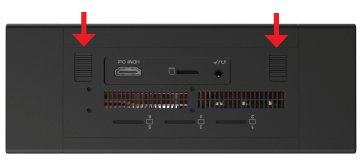
Charging the internal battery
To charge the internal battery without removing it from the encoder, connect the provided AC power adapter to the DC input on the unit and plug the other end of the adapter into an electrical outlet. The battery will then begin to charge. When the encoder is turned off, the battery will charge significantly faster (in approximately 3 hours).
Note: An optional external TVU POWERPAC battery can extend the internal battery runtime.
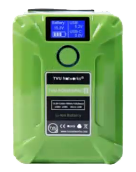
For more information refer to the POWERPAC Quick Start User Guide at https://www.tvunetworks.com/tip/tvu-powerpac-quick-start-user-guide/
Inserting SIM cards
The encoder SIM card slots are designed to hold up to 6 Nano SIM (4ff) cards in three embedded modem slots. These SIM configurations are user serviceable.
Note: The encoder SIM card slots only accept Nano SIM (4ff) cards.
Complete the following steps to insert a SIM card into the embedded modem slot on the encoder:
- The RPS One model TM1100 features three dual SIM card carriers for use with the internal modems. To remove a SIM card carrier, push the SIM card in until it clicks and slightly pops out. Carefully pull the dual SIM tray out of the slot.
- Place 2 SIM cards into the dual nano SIM card tray as shown below and carefully slide the carrier into the embedded modem slot. Ensure the SIM cards stay in their respective carrier recesses during this process.

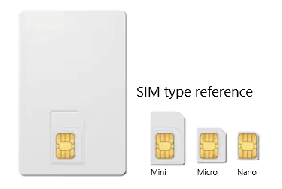
RPS One backpack configurations
The RPS One encoder is designed to be a standalone encoder to transmit from a wearable backpack configuration. The backpack comfortably holds the pack while allowing users easy access to the power button, connections, and SIM card slots.
The touchscreen LCD interface on the pack can also be used while the unit is in the backpack. In addition, the backpack features breathable mesh that allows for the essential ventilation of the encoder to prevent overheating.
TVU RPS One and backpack
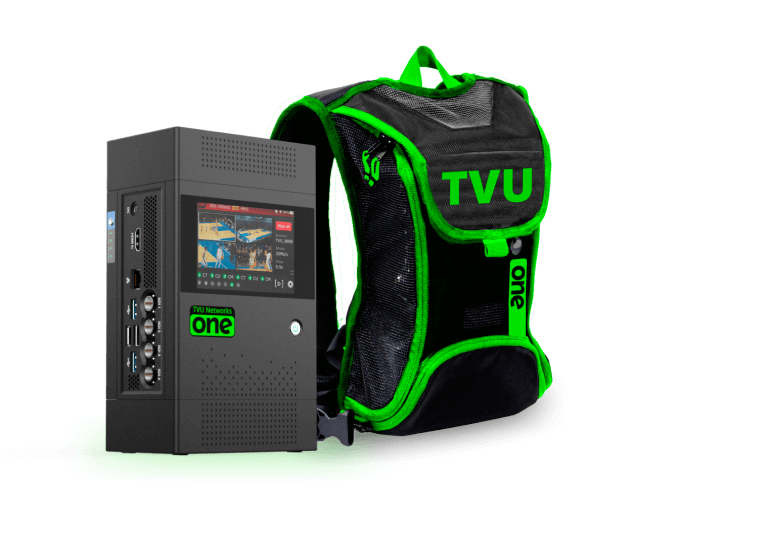
POWERPAC Li-Ion battery
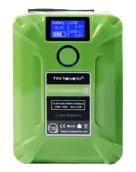
There are two TVU RPS One backpack configurations for external batteries:
V-type battery configuration:
- V-type battery with a green connector
G-type battery configuration:
- G-type battery with a green connector
V-type battery configuration example:
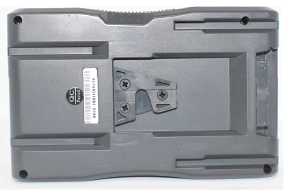
Model TM1100 V-type battery, green connector (optional):
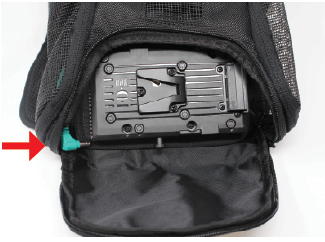
G-type battery configuration example:
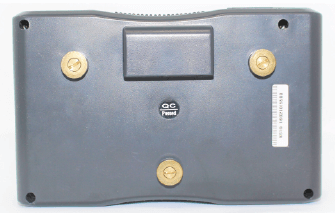
Model TM1100 G-type battery, green connector (optional):
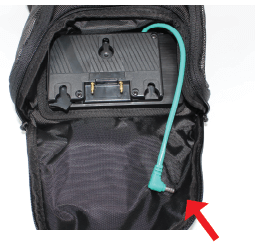
Chapter 3 – Product specifications – Model TM1100 encoder
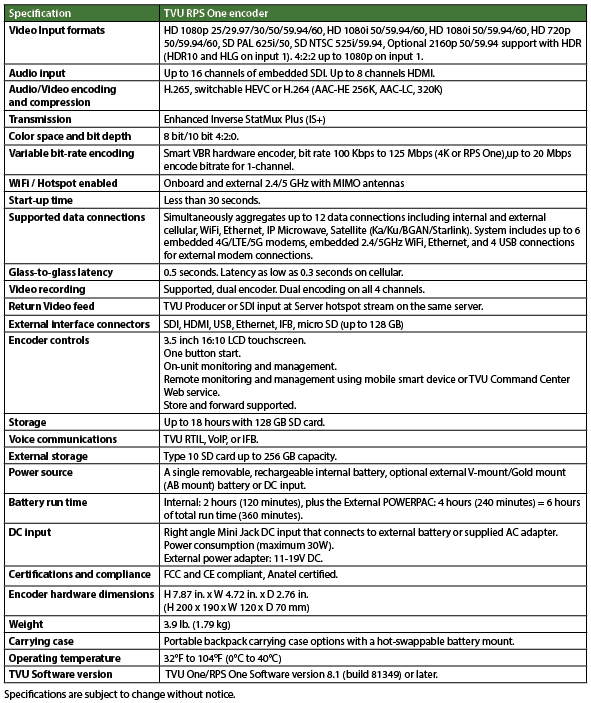
© Copyright 2024 TVU Networks Corporation. All rights reserved in all media.
Document Part Number: TVU RPS One HW UG Rev C EN 07-2024